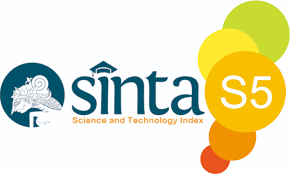Aplikasi Penjualan Fokus Komputer Menggunakan Bahasa Pemrograman PHP dan Metode Apriori
Abstract
Information technology-based sales applications have emerged as essential solutions for optimizing sales processes, tracking inventory, and understanding customer purchasing patterns. Fokus Computer Store offers a range of products, including computer components, laptops, as well as accessories such as mice, mouse pads, keyboards, USB drives, and other computer components. However, challenges arise in sales efficiency, where certain items tend to accumulate without being sold over extended periods, impacting the store's cash flow. Therefore, an application capable of providing product recommendations based on previous sales data becomes crucial in assisting the store in effective inventory management and maintaining a smooth cash flow. The Apriori method is one form of association rule in the field of data mining. Alongside Apriori, there are other methods within this category, such as Generalized Rule Induction and Hash-Based Algorithms. The Apriori method, being a proven effective algorithm for association analysis, will be employed to uncover potential hidden purchasing patterns within the store's transactional data. By analyzing customer purchase data, this application can identify relationships between frequently co-purchased products. The results of this analysis can be utilized to formulate product recommendations for customers, enhance cross-product sales opportunities, and support inventory management decisions. This application can serve as a point-of-sale system at Fokus Computer Store, with the ability to display the outcomes of the Apriori algorithm calculations based on the input sales data. Despite the application developed by the author having certain limitations, particularly in terms of user interface and data, the author anticipates receiving constructive criticism and suggestions to aid in refining the application for the betterment of its future iterations
Downloads
References
S. Styawati, A. Nurkholis, and K. N. Anjumi, “Analisis Pola Transaksi Pelanggan Menggunakan Algoritme Apriori,” J-SAKTI (Jurnal Sains Komput. dan Inform., vol. 5, no. 2, pp. 619–626, 2021.
I. Maryani, O. Revianti, H. M. Nur, and S. Sunanto, “Implementasi Data Mining Pada Penjualan Di Toko GOC Kosmetik Dengan Menggunakan Metode Algoritma Apriori,” Indones. J. Softw. Eng., vol. 8, no. 1, pp. 92–98, 2022, doi: 10.31294/ijse.v8i1.13017.
F. Ardhy, O. J. F. Wassalam, T. H. Andika, and S. A. Salimu, “Penerapan Data Mining Menggunakan Algoritma Apriori Dalam Memprediksi Penjualan Produk,” J. Inf. dan Komput., vol. 10, no. 2, pp. 18–23, 2022, doi: 10.35959/jik.v10i2.385.
N. N. Merliani, N. I. Khoerida, N. T. Widiawati, L. A. Triana, and P. Subarkah, “Penerapan Algoritma Apriori Pada Transaksi Penjualan Untuk Rekomendasi Menu Makanan Dan Minuman,” J. Nas. Teknol. dan Sist. Inf., vol. 8, no. 1, pp. 9–16, 2022, doi: 10.25077/teknosi.v8i1.2022.9-16.
M. (2018) Siregar, H. F., Siregar, Y. H., & Melani, “Perancangan Aplikasi Komik Hadist Berbasis Multimedia. JurTI (Jurnal Teknologi Informasi), 2(2), 113-121.,” JurTI (Jurnal Teknol. Informasi), vol. 2, no. 2, pp. 113–121, 2018.
A. Nastuti and S. Z. Harahap, “Teknik Data Mining Untuk Penentuan Paket Hemat Sembako Dan Kebutuhan Harian Dengan Menggunakan Algoritma FP-Growth (Studi Kasus Di Ulfamart Lubuk Alung),” J. Ilm. Fak. Sains dan Teknol., vol. 7, no. 3, pp. 111–119, 2019.
E. D. Sikumbang, “Penerapan Data Mining Penjualan Sepatu Menggunakan Metode Algoritma Apriori,” J. Tek. Komput. AMIK BSI, vol. Vol 4, No., no. September, pp. 1–4, 2018.
M. Harmizi, Azanuddin, and Elfitrian, “Estimasi Data Mining Tingkat Kecelakaan Lalu Lintas Kabupaten Serdang Bedagai Menggunakan Algoritma Regresi Linier Berganda,” no. x, 1978.
J. R. Gumilang, “Implementasi Algoritma Apriori Untuk Analisis Penjualan Konter Berbasis Web,” J. Inform. dan Rekayasa Perangkat Lunak, vol. 1, no. 2, pp. 226–233, 2021, doi: 10.33365/jatika.v1i2.612.
P. Iswandi, I. Permana, and F. N. Salisah, “Penerapan Algoritma Apriori Pada Data Transaksi Penjualan Hypermart Xyz Lampung Untuk Penentuan Tata Letak Barang,” J. Ilm. Rekayasa dan Manaj. Sist. Inf., vol. 6, no. 1, p. 70, 2020, doi: 10.24014/rmsi.v6i1.7613.
A. Firman, H. F. Wowor, X. Najoan, J. Teknik, E. Fakultas, and T. Unsrat, “Sistem Informasi Perpustakaan Online Berbasis Web,” E-Journal Tek. Elektro Dan Komput., vol. 5, no. 2, pp. 29–36, 2016.
B. Prasetyo, T. J. Pattiasina, and A. N. Soetarmono, “Perancangan dan Pembuatan Sistem Informasi Gudang (Studi Kasus : PT. PLN (Persero) Area Surabaya Barat),” Teknika, vol. 4, no. 1, pp. 12–16, 2015, doi: 10.34148/teknika.v4i1.30.
S. Santoso and R. Nurmalina, “Perencanaan dan Pengembangan Aplikasi Absensi Mahasiswa Menggunakan Smart Card Guna Pengembangan Kampus Cerdas (Studi Kasus Politeknik Negeri Tanah Laut),” J. Integr., vol. 9, no. 1, pp. 84–91, 2017.
T. Suryana, “Belajar Bahasa Pemrograman Dart,” Tek. Inform. Unikom, no. 1, p. 4, 2021, [Online]. Available: https://repository.unikom.ac.id/68459/
Copyright (c) 2024 Arya Gilang Ramadhan; Pahrizal Pahrizal, Ardi Wijaya, Rozali Toyib

This work is licensed under a Creative Commons Attribution-ShareAlike 4.0 International License.
An author who publishes in Jurnal Media Infotama agrees to the following terms:The author holds the copyright and grants the journal the right of first publication of the work simultaneously licensed under the Creative Commons Attribution-Share Alike 4.0 License which allows others to share the work with acknowledgment of the work's authorship and initial publication in this journal.Submission of a manuscript implies that the submitted work has not been previously published (except as part of a thesis or report, or abstract); that it is not being considered for publication elsewhere; that its publication has been approved by all co-authors. If and when a manuscript is accepted for publication, the author retains the copyright and retains the publishing rights without limitation.
For new inventions, authors are advised to administer the patent before publication. The license type is CC-BY-SA 4.0.
MEDIA INFORMATION REVIEW: Journal of the Faculty of Computer Science is licensed under a Creative Commons Attribution-ShareAlike 4.0 International License.You are free to:Share
— copy and redistribute material in any medium or formatAdapt
— remix, modify and develop materialfor any purpose, even commercial.
The licensor cannot revoke this freedom as long as you follow the license terms












.png)


